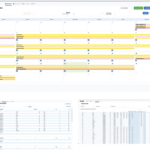Despite their obvious differences, shoot-from-the-hip Michael Wiener, owner of Aerial Rigging, Inc., and a thoughtful, slightly reserved Steven Shaw, head of Performance Rigging Systems, Inc., Aerial’s affiliate, seem to have made a pretty good match.
Since they joined forces in 2011, Wiener and Shaw combined their strengths to benefit both divisions, which operate under the umbrella company, The Performance Group. A key focal point: Performance Rigging Systems’ new load cell system that offers riggers greater accuracy in determining live, real-time load calculations to prevent overloads.
The Performance Group, which now operates from a 15,000-square foot building in Lakeland, FL and has catered to the hospitality, theme park and other industries for 25 years, has grown considerably since Wiener assumed control in 1999.
Like so many other firms serving the hotel and convention industry, Aerial has had to overcome stormy economic weather, including the financial downturns after 9-11 in 2001 and the more recent one in 2008-2009. But its business has also been jolted with new ideas that have struck like a bolt from the blue.
“You get locked into a way of thinking and doing things,” says Wiener. “Then lightning strikes and it makes you think, ‘That might work. That might be different.’”
Much like the products they make available, Aerial and The Performance Group are compact, agile and get the job done. “Hopefully, we’re providing needed products that you wouldn’t expect Aerial to bring to market,” says Wiener.
No Stranger to Danger
One way The Performance Group maintains a competitive edge is via innovative thinking. After flirting with writing a load calculation app for Windows Mobile, Shaw, who has two decades of experience as a rigger (seven of those certified in the arena and theater fields), instead developed his prototype for what would become Performance Rigging’s shackle load cell measurement system.
“Being a production rigger, having toured, I’ve seen a lot of accidents,” says Shaw. “A lot of these accidents could have been avoided.”
Shaw admits that some production crews might be completely unaware of the danger lurking all around — and above — them. Just because a truss appears to be balanced, it doesn’t mean the load it carries is evenly distributed across the structure. Often, some hoists are being taxed more than others, which can result in serious injury to the production team and to the audience.
“I wanted to develop something that was compact, easy to use and could withstand the abuse of touring to make riggers’ lives easier,” says Shaw.
Shaw, who was heading up his own LevPro company at the time, got the chance to refine his load cell system after sending sent it on tour with Britney Spears and four Cirque du Soleil arena acts (i.e. Saltimbanco, Alegría, Quidam, Dralion) throughout 2009 and into 2010.
After receiving feedback from the head riggers as to how he could improve upon his “first generation” design, Shaw took their advice regarding such issues as load-cell connectors (Shaw now uses a 5-pin XRL instead of Ethernet RJ-45 connectors) and employing a better lanyard — one that uses a stainless steel wire rope with a nylon coating. Overall, the feedback was encouraging.
Flash forward to 2011. Shaw meets Wiener at InfoComm and the two hit it off. Wiener is impressed with Shaw’s system and presentation, and Shaw sees the potential of working with a mobile, forward-thinking partner.
“I have a nose for business, and I kept saying, ‘There’s something here,’” says Wiener. “Then Steve was out on tours a lot and I approached him at some point later and said to him, ‘Look, if you want to do this seriously, you have to get off the road and concentrate on this full time.’”
Shaw came off the road and Performance Rigging Systems was born. “We then talked a lot about the improvements needed to the system,” says Shaw. “A second generation was then launched at InfoComm 2012.”
 Receiving Signals
Receiving Signals
So, how does Shaw’s load cell system actually work? “The load cell is installed inside the pin [that’s threaded through a shackle], and the cell itself contains circuits,” says Shaw. “We replaced the bolt of a typical Crosby safety anchor shackle with a stainless steel load pin. To get started you could simply replace the existing shackle you use to connect the span sets. That way there’s no loss of headroom.
 “It’s a strain gauge, it senses the stretch of the material, which transfers information into an electrical signal that’s sent into a repeater box mounted up on a truss or audio stack or down by your hoist controllers,” Shaw continues. “Each load cell is connected to a repeater box, and each repeater box can hold up to eight load cells. The data is then [wirelessly] transmitted via Bluetooth into your laptop, up to 300 feet away. Once the data is transmitted, a mathematical conversion is done [via the software], changing the measurements from mAs [milliamps] into pounds or kilograms.”
“It’s a strain gauge, it senses the stretch of the material, which transfers information into an electrical signal that’s sent into a repeater box mounted up on a truss or audio stack or down by your hoist controllers,” Shaw continues. “Each load cell is connected to a repeater box, and each repeater box can hold up to eight load cells. The data is then [wirelessly] transmitted via Bluetooth into your laptop, up to 300 feet away. Once the data is transmitted, a mathematical conversion is done [via the software], changing the measurements from mAs [milliamps] into pounds or kilograms.”
 “The person at the laptop can see on his spreadsheet, in real time, all of the motors,” adds Wiener.
“The person at the laptop can see on his spreadsheet, in real time, all of the motors,” adds Wiener.
“If any of the load cells hits or exceeds a predetermined overload limit, [the load cell] sends a signal that turns a relay on and that actually sets the e-stop on the hoist controller,” says Shaw.
Eliminating Guesswork
“Our load cells are within .5 percent accurate,” says Wiener. “Any temperature, any conditions, any anything. When somebody uses our load cell system they can have 100 percent confidence that what they are seeing on their laptop, which is a reading from those point loads, is accurate.
“All of that information can be exported to an Excel spreadsheet. So, now, the tours or one-off shows can have an accurate logbook of what their loads were at the time of the show. If anything unforeseen happens, all production has to do is hand over that documentation, that logbook, to the engineers who are evaluating the accident and show proof that the [load] was within limits,” says Shaw.
Performance Rigging Systems uses SRS Light Design hoist controllers that feature automatic phase alignment modules and voltage meters, which boost the system’s ability to activate its limit switches, helping riggers avoid severe equipment damage and even electrocution. “You’ll never be in jeopardy of bypassing the limit switches,” says Shaw. “With other hoists you can go past the limit and damage the switch.”
In addition, the motor controllers are wireless, in the sense that a rigger can operate the gear via a remote hand-held pendant. “With the wireless pendant, the rigger running the controller can walk up to the load, see what needs to be done and make adjustments,” says Wiener.
Forked for Life
The Performance Group has also expanded its business to include a patent-pending wind-dissipation roof system and new extra-strength 12” x 12” forked box trussing. “We had an idea that by using fork trussing — and up till now the American market, for the most part, has used nuts and bolt trusses — we could provide a stronger, more compact truss,” says Wiener.
The company did, indeed, find an affordable way to produce forked trusses using stainless steel connectors via overseas manufacturing, with load factors set by the Cincinnati-based engineering solutions firm, Entertainment Structures Group.
“In the domestic marketplace, the heavier stuff always used forks,” says Wiener. “But nobody has used [forked trusses] for a 12” x 12” box. It hasn’t been economically feasible. But by producing [the trussing] overseas, I can bring the same strength to a 12” x 12” that a 20.5” piece of truss has — and you can save space in transporting.”
These forked trusses are yet another example of how The Performance Group is reaching beyond its comfort zone to create products that promise to create a safer working environment. Wiener uses the word “kismet” to describe the events that have transpired regarding the success of Performance Rigging’s load cell system, but is also quick to point out that this tells only half the tale. “Steve has busted his chops,” says Wiener. “He’s worked his a** off.”
Shaw even attended Chain Master classes in August 2012 in Germany for one week to get up to speed on the inner workings of Chain Master’s hoist equipment, controllers and load-cell system and automation. (The Performance Group has since become an authorized service and parts center for Chain Master as well as distributor of their products.)
“I know it sounds pie-in-the-sky, but with Steve coming on board, it’s put us into a different mindset,” says Wiener. “As with most things, the marketplace will determine our success. I think we’re on a good path right now and hopefully we’ll continue to travel down that road.”
For more information on Aerial Rigging and Performance Rigging Systems, go to www.aerialrigging.com and www.performancerigging-systems.com.


